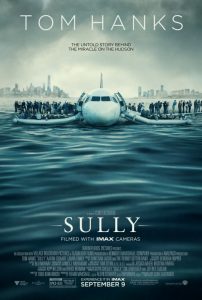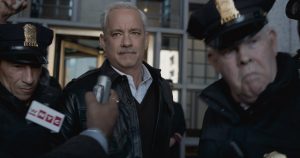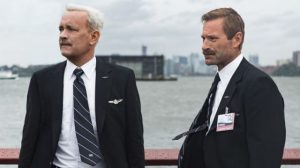
“Sully” is an awkwardly structured film. It doesn’t open with the recreation of the “Miracle on the Hudson” as one might expect. Instead, we are introduced via a nightmarish cop out of the incident if it were a failure, with the plane crashing into the city. This is a stroke of brilliance on Clint Eastwood’s part, putting the audience into the psyche of Captain Chesley Sullenberger (Tom Hanks). He awakes from this nightmare in a cold sweat, no doubt not the first time this has occurred. He has these nightmares throughout the film, including hazes where he stares out his hotel window and envisions his plane zooming past him as it careens toward a nearby building. Every time one believes they’re about to bear witness to the actual event, the wool is pulled over their eyes. It’s a state of disillusion, one shared with Sully as he copes with his life-altering emergency landing.
And then, the actual incident is recreated…roughly thirty to forty minutes into the film. It’s edited in as a flashback had by Sully as he watches yet another news report on the incident in a bar presided over by Michael Rappaport. His flashback is so strong that he somehow attains the vision of the passengers pre-boarding, the citizens of New York City watching as the plane flew by headed toward the Hudson, and of air traffic control scrambling to gain supervision of the situation. It is not a nightmare like before, but the recreation we expected at the outset, strangely placed in the middle.

I will not deny the power of Eastwood’s direction of the plane landing. It is as harrowing as expected, but much more grounded and realistic. He doesn’t linger on the hysterics of the passengers, as hinted at via their introductions, instead highlighting the frozen fear and despair overcoming them. I did not time the recreation, so I can’t validate if it was done in real time to match the two-hundred and eight seconds of the actual incident. It sure felt like it, going by in a flash. The immediacy of the situation is gripping and I respected that Eastwood adhered to realism! Even the possibly manufactured elements encased in the aftermath, such as passengers swimming to shore, feels like an actual reflection of their paranoia getting the best of them and not a cheap dramatic trick.
What I will address is how the inclusion of the recreation surprisingly dragged the film down. Up until this point, the film was a character study of an average man overwhelmed by the newfound media craze and personal doubts caused by an unforeseen emergency landing. Once the recreation is introduced, that’s practically dropped in favor of a heroic crusade against the National Transportation Safety Board. The news reel that caused the flashback in Sully conveniently gave him the foresight to challenge the simulations by bringing up human error and timing. What could’ve sank him, those simulations that showed he could’ve successfully landed in a runway, are now eradicated by the proof that, without prior practice and immediate response (which he obviously lacked), he couldn’t have landed the plane successfully outside of in the Hudson.

The film went from a smart and effective character study to a manufactured drama, one that exaggerated the NTSB’s interrogation. The board members are presented as vultures looking for an error to sink Sully’s career. In reality, the NTSB’s months-long investigation into the incident was a routine one. Yes, it included the accusations seen on screen, but they weren’t done maliciously. In order to fully understand an incident and prevent further ones, they are required to ask questions about the mental stability of Sully and his co-pilot, Jeff Skiles (Aaron Eckhart). The simulations aren’t meant to diminish or attack their abilities, but get a reading on other pathways. The inspection of the plane’s damages is a necessity, not an indictment of Sully’s testament. The NTSB weren’t antagonistic towards Sully and Jeff according to first-hand accounts. All parties worked together calmly and proficiently.
I realize the nature of the manufactured drama, as did the real Sully, who acted as an adviser on the film. He understood that, for entertainment purposes, the NTSB’s role was to be antagonists towards Sully and Jeff’s protagonists to strengthen the victorious happy ending. Simply recreating the incident wouldn’t have sufficed a feature length film, so the happy ending had to come elsewhere. The problem is it’s too heavy-handed. When the accusations against Sully and Jeff are flung at them at a board hearing, multiple people in my screening uttered “Bullshit” in response. They did because, well, it was bullshit! It was manufactured bullshit that reeked of it and, while the overall sequence was competently shot, it lacked the impact it needed because of the bullshit weighing it down.

Don’t get me wrong; I liked “Sully!” The recreation of the “Miracle on the Hudson” is thrilling, with the perspective entirely from the cockpit shown during the hearing masterfully crafted! Tom Hanks is in superb form as Sully, embodying his humility and shaken demeanor in the wake of a near tragedy! My problem is these instances of excellence weren’t complemented by the weaker aspects of the film, causing them to stumble. Had it been structured differently, possibly with the recreation at the outset as expected, it would’ve flowed much smoother. Sully’s crusade against the NTSB would’ve been in line with his deteriorating mental state, making the victory feel like just that. Instead, the experimental structure as is loses sight of its rooted drama in favor of histrionics.
“Sully” is a decent film that could’ve been a great one.
Final Rating: B-
